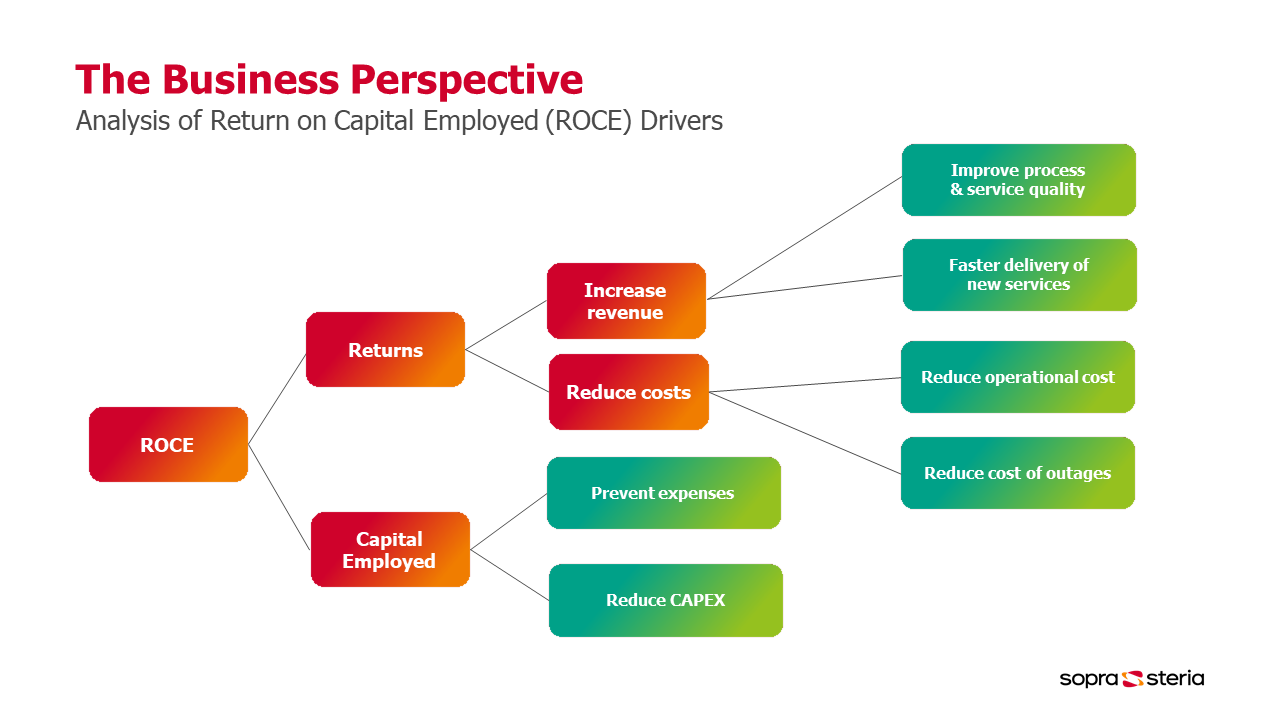Managing your applications is one thing. Modernising your applications is an entirely different ballgame: more challenging, but also a lot more rewarding. As in ‘financially rewarding’, to be precise. Here’s why even CFOs need to take note of the benefits of Smart Application Modernisation (SAM).
Let’s take a step back first and talk just a little bit about the value of going digital. Looking at digital transformation from a business perspective, it always boils down, for us at any rate, to analysing the business drivers of your company's return on capital employed (ROCE). This ROCE is a financial metric that measures a company's profitability and the efficiency with which its capital is employed. Those business drivers are invariably also tied to the drivers behind your digital transformation. In essence you want to spend less cost, improve productivity and your top line and invest into your future business. But a deeper analysis is needed to make it specific to your company.
Business and technology drivers
We start our analysis with a more general look at your business goals and challenges, as well as the trends in your particular industry. Then we look specifically for your ROCE drivers. These are basically your returns, which can be improved by either increasing your revenue or reducing your costs, and your capital employed.
These business drivers in turn can be linked to technology drivers, such as a faster delivery of new services, or the improvement of your process and service quality, either of which can lead to an increase in your revenue. Other examples are the reduction of your operational cost as well as your cost of outages, which can help to reduce your costs in general. And finally, by preventing expenses or reducing your capital expenditure (CAPEX), you can allow for less capital to be employed.
Perform, transform, reinvent
Those six technology drivers just mentioned, can be roughly divided into three categories – a three-stage rocket for digital transformation, if you like. The first stage is focused on efficiency, the second on effectivity and business value and the third on innovation.
Reducing your operational cost and your cost of outages squarely falls into the first category: ‘Perform’. By rationalising your IT spend, through industrialisation and a state-of-the-art service delivery, you can drive financial efficiencies. Or, to put it more bluntly, save a substantial amount of money. Which is always of interest to any CFO, I would imagine.
At this first stage of digital transformation, IT acts purely as a support function. At the second stage, IT also acts as a business partner, improving not just the efficiency but also the effectivity of your business processes and generating indirect benefits in the process. In this second category of technology drivers, called ‘Transform’, you can find expense prevention, focus on business value and the improvement of your process and service quality. It is, in effect, the implementation of agile delivery with digital, end-to-end, user-centric services that allows IT to bring tangible value or benefits to your business. Benefits that can take on the form of freed capacity, a faster time to market, more reliability, an agile way of working and, above all, a step up for a growing innovation deployment.
Those business benefits can also be calculated in terms of monetary value or savings. Added up to the monetary savings from the ‘Perform’ stage, this usually results in a nice sum that you can either set aside as profit or reinvest in your business. Which brings us to the third category of technology drivers, called ‘Reinvent’. This includes the reduction of your capital expenditure (CAPEX) as well as a focus on reinventing new business processes and faster delivery of new services. It is directly aimed at accelerating your digital transformation by experimenting with disruptive business processes and delivery models. All of this amounts to the third and final stage of digital transformation, in which IT acts as a key stakeholder of your business strategy.
If all of the above proves one thing, it’s that there is definitely value in going digital. Furthermore, this business value also translates in clear financial benefits, which should be enough to raise the interest of any CFO.

In my next blog post I will explain how all of this relates to the discipline of application management or, better yet, application modernisation. Meanwhile feel free to take a peek at our corporate page on that topic. Or check out this previous blog post.